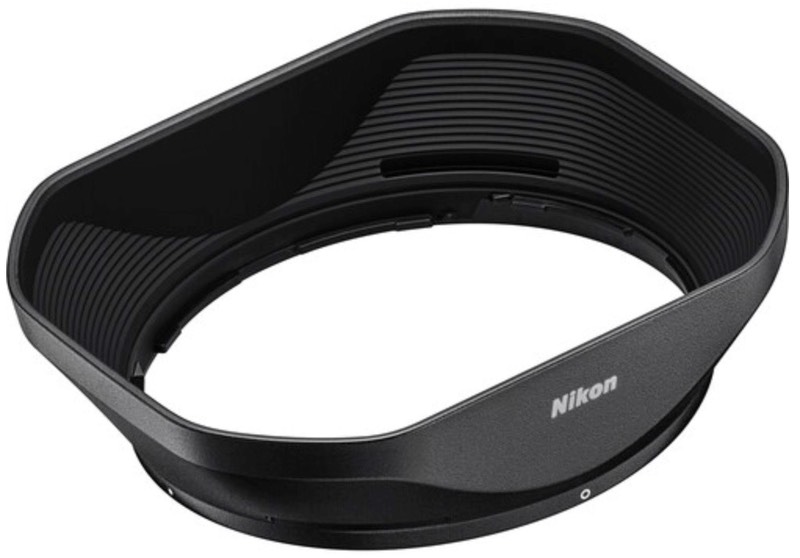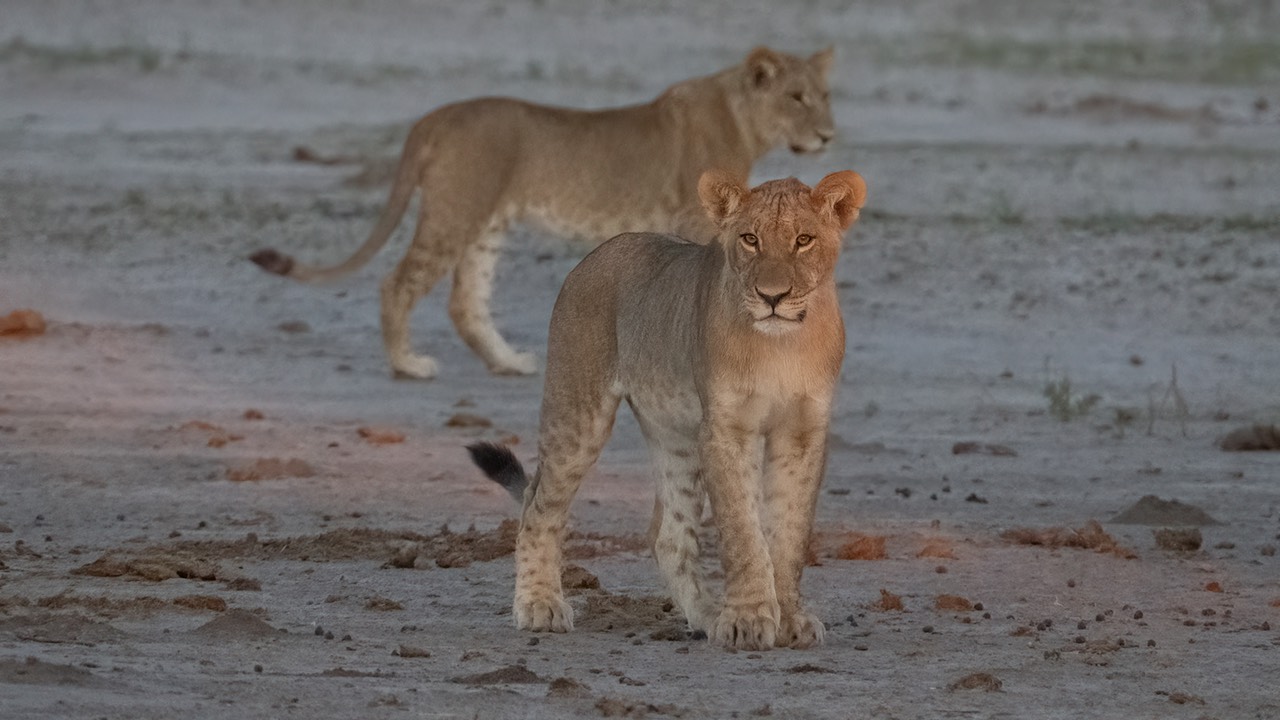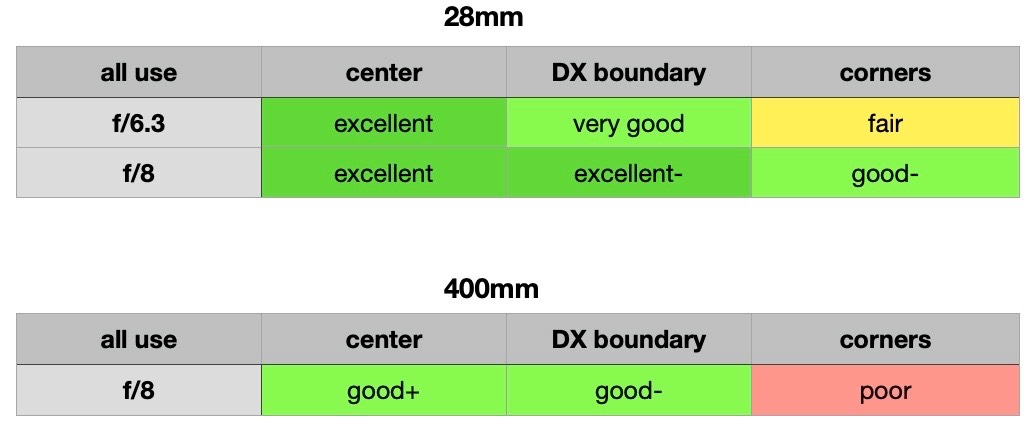What is It?
Once a zoom lens focal length range begins to approach 10x (e.g. the original Tamron 28-200mm in the film world), we call that kind of lens a "superzoom." I believe it important to distinguish such lenses with a group name, because their design considerations and constraints are a bit different from lenses with much more limited focal ranges (e.g. the more typical 2x to 3x ones).
Beyond the problem of controlling optical issues over a broad focal range, most superzooms also have the problem of transitioning from wide angle optical design to telephoto optical design. Crossing below 35mm or above 100mm starts introducing additional design considerations that get quite complex.
Nikon's had a relatively long history of making superzooms, from the 50-300mm f/4.5 in 1966, to the 35-200mm f/3.5-4.5 in 1985, to the 28-300mm f/3.5-5.6G VR introduced in 2010. However, much of Nikon's experience with the long focal length crossover lens is actually with Coolpix (24-3000mm equivalent!) and DX lenses (18-300mm f/3.5-5.6G VR, or essentially 28-450mm equivalent).
We already had one Z-system superzoom, the 24-200mm f/4-6.3 VR, so Nikon's introduction of a second one here in 2024 was a surprise. The 28-400mm f/4-8 VR is FX superzoom with the largest focal range (14x) that Nikon has built, and represents a remarkable achievement just in the fact that it exists.
However, the very first thing you have to consider now is the "extra" wide end (24-200mm) versus the "extra" long end (28-400mm). Don't underestimate that difference. At 24mm you're looking at 74° horizontal view, while at 28mm you're at 65° horizontal view. That's a bigger difference than most people realize. At the telephoto end, 200mm is 10° horizontal while 400mm is 5.2° horizontal, also a tangible difference.
I've noticed already that the wide/telephoto differences are already causing people to question whether they need the 24-200mm or the 28-400mm as their all-in-one lens. A simple way to think about it: the closer your subjects, the more you need the extra wide view of 24mm; the more distant your subjects, the more you'll value the extra telephoto view of 400mm. Of course, these are "all-in-one" lenses, so you're wanting both ;~). But the shorthand, 24mm for closer subjects, 400mm for distant subjects is one that you should be considering.
So how did Nikon build the 28-400mm f/4-8 VR? With a lot of glass. Inside you've got 21 elements in 15 groups, and to control all the optical issues over such a large range Nikon used three aspherical and four ED elements. There are three "groupings" within the lens: the frontmost eight elements move forward with barrel extension, the inner ten elements are dealing mostly with focus and focal length alignment, and the rearmost three are used to make the exiting light as telecentric as possible. That last element in the rear is aspherical and large.
The 28-400mm maximum aperture works out something like this:
- 28mm — f/4
- 30mm — f/4.2
- 34mm — f/4.5
- 38mm — f/4.8
- 41mm — f/5
- 44mm — f/5.3
- 50mm — f/5.6
- 62mm — f/6
- 88mm — f/6.3
- 105mm — f/6.7
- 130mm — f/7.1
- 165mm — f/7.6
- 200mm — f/8
That's a pretty fast progression from f/4 to f/8, and means that if you're using this lens for the 200-400mm range over the 24-200mm, you're always at f/8. On the 45mp cameras, depending upon how you calculate, we're either near or at the point where diffraction becomes a clear limiting factor in MTF results.
At the 400mm end, the apertures available are f/8 to f/45, though I fail to see how you'd really want the latter on today's high pixel count cameras. The aperture diaphragm is 9 rounded blades.
The thing driving the aperture bit is the size of the 28-400mm f/4-8 VR lens: it's only 5.6" (141.5mm) in length at 28mm, and it has a front filter ring size of 77mm (diameter of the lens is 3.4", or 84.5mm). Zoomed to 400mm, the lens extends another 3.5" (93.5mm) via a dual inner barrel telescope. While not exactly light, the lens also only weighs 25.6 ounces (725g). However, that's only a quarter of a pound heavier than the 24-200mm.
Focus is a minimum of 8" (0.2m) at 28mm, where the maximum magnification works out to 1:2.9. At 400mm, the minimum focus is 48" (1.2m) and the maximum magnification is unspecified, though still pretty good.
Meanwhile, the VR ability of the lens is stated as 5 stops CIPA at 400mm using the Normal VR setting, or 5.5 stops with Synchro VR-equipped bodies (Zf, Z8, Z9).
There's not much more to say about the lens: it has a zoom ring, control ring (focus, by default), and a zoom lock switch to keep the lens from extending during travel. Surprisingly for a more consumer-oriented lens, it has dust and drip-resistant sealing. No tripod mount is supplied or optional (though I suspect a third party will eventually make one. The lens comes with a rectangular-shaped HB-114 lens hood.

The 28-400mm f/4-8 VR sells for US$1300 and is made in China.
Source of the reviewed lens: purchased
How's it Handle?
The wide zoom ring is quite stiff on my sample, to the point that you simply can't finger-roll a zoom, you need to exert concerted force. While that might seem like a bad thing by itself, that stiffness does mean that the lens does not zoom creep when pointed up or down. In fact, with the lens fully zoomed to 400mm and placed front down on a table by itself, the lens moves to maybe 350mm and then stops the resistance is so high. There's a range in the 150-200mm focal length where the lens is slightly more susceptible to creep.
Nikon supplies a zoom lock on the 28-400mm f/4-8 VR, but that only works at 28mm.
While the lens barrel extends over 3.5" (~40mm) during zoom via a double inner barrel, this telescoping is much more resilient to side forces than other long extensions I've seen; there's no side-to-side alignment slop when zoomed into 400mm. Note that the front ring rotates slightly on zooming, so if you're using a circular polarizer you'll need to reset it.
On a big camera such as the Z9, some might find the focus control ring too close to the camera body.
How's it Perform?
Focus: focus breathing is surprisingly low. It's visible, but measures in the low single digit percentages, which for many focus pulls will simply not show up.
Focus speed was surprisingly good, certainly as good as the 180-600mm f/5.6-6.3 VR.

At 400mm and 100% view, there's a touch of diffraction-like softness, but that generally can be controlled. Note that this photo was taken at O-Dark-Thirty, so image noise is also competing with detail.
In full sun with the optical sharpness not competing with noise, the detail in the lion's fur is much more clear as he shows a Flehman response. There's still a bit of small blur that requires sharpening to remove, though (as has been done in the above image).
Sharpness: Nikon's MTF charts indicate that the 28-400mm f/4-8 VR should be very good at 28mm: near perfect central performance with a bit of astigmatism approaching the corners. Heck, I'd call that theoretical performance exceptional for a zoom that has as much focal length capability as this lens. At the long end, again the central MTF looks quite good, but there's more of a clear corner fall off. The wide angle MTF shows some potential field curvature issues, though. Still, overall, the MTFs look somewhat better for the 28-400mm f/4-8 VR than they do for the 24-200mm f/4-6.3 VR zoom. So how's that play out in real life?
At 28mm, the center is excellent, the DX boundary is very good, but the extreme FX corners are only fair. 28mm appears to be the best focal length for the lens in the primary framing areas, and in test images I made I was actually quite impressed with the 28mm performance. The degradation from DX boundary to FX boundary happens very close to the FX boundary, so at 28mm there's a very wide framing of very usable pixels. Snappy pixels (on a 45mp camera).
As you zoom in, everything gets a little less capable, though in comparing my sample to what I've seen from others, it appears I have a very good sample of the lens. At 400mm, the center is what I'd call good+, the DX boundaries are good- or fair+, but the FX corners are poor. Also, the "snap" is gone. Some of this is a bit of diffraction slipping into visibility, as we're at f/8 on a 45mp camera. But not all of it. That's because at 200-300mm the lens is better than it is at 400mm, despite f/8 being the maximum aperture there, too. Indeed, I'd tend to call the center very good- at 250mm, the DX boundary good, and the FX corners fair-.

Field curvature seems to be an issue with this lens, though, which is one reason why the test chart results may seem a bit harsher than long distance field results. In particular, if you push to the closest focus distance with this lens at 28mm (1:2.6), expect the corners to be a full blur, and the blurriness starts even before the DX boundaries due the field curvature. At 400mm and minimum focus distance (1:3.2), things are better, with the lens performing closer to what I described above.
Using a Z8 with Pixel Shift on test charts with the lens seems to verify that the center performance of the 28-400mm f/4-8 is actually extremely good, though it is slightly behind the 100-400mm f/4.5-5.6 VR S at every focal length they share in the center, as well as behind in the outer areas.
The other comparison you're probably interested in is with the 24-200mm f/4-6.3 VR: here the 24-200mm is a bit behind my 28-400mm sample at 28mm across the frame, betters the reviewed lens from 35-105mm (particularly in the corners), and then starts to fall behind again as you approach 200mm. Both lenses have "better" and "worse" focal lengths as you zoom, which is a compromise you see in the longer focal length range zooms as they try to manage all parameters for all possibilities.
Simply put, I'd pick the 100-400mm f/4-5.6 VR S over the 28-400mm f/4-8 VR, as you might expect. The extra stop and better optical control is desirable in low light conditions. But if you don't need fully realized FX corners, I'd probably pick the 28-400mm f/4-8 VR over the 24-200mm f/4-6.3 VR, particularly if I was using 200mm a lot.
Coma is an issue with this lens. While the amount is on the modest side, the coma smear has a colored component to it that will show up. It's one of the reasons why the test results are slightly lower than they could be.
Vignetting: At 28mm, the vignetting is not fully corrected, even with vignette correction applied. The very corners are more than two stops down, but the area in which vignetting is minimal is actually quite wide, with only the corners showing what almost looks like image circle clipping. Stopping down to f/8 brings us to the level I call ignorable.
At 400mm, the vignetting circle moves in towards the DX corners, but is not nearly as problematic, showing just over a stop in the extreme corners, and less than a stop over a very broad range of the frame. At f/11 and DX, the level (without correction) is very close to my "ignorable" mark, and using vignette correction achieves that at f/8, too.
Linear distortion: You cannot switch off distortion control in the camera with this lens, and the results out of camera are quite minimally pin-cushioned. Without the distortion control applied, the lens has considerable (>5%) barrel distortion which has flipped to moderate pin-cushion distortion (as much as 1.5%) in the 50-200mm range. Only 400mm, curiously, is pretty devoid of linear distortion.
Chromatic aberration: Surprisingly, there's a slight bit of longitudinal CA wide open with the 28-400mm f/4-8 VR at 28mm f/4, but it's minimal enough to generally be ignorable. I did not see any lateral CA of note with the lens corrections applied; it almost measured zero. Without them, there is significant lateral CA at pretty much every focal length and aperture combo.
Flare: Well controlled with light sources in frame and at frame boundaries at the mid-range focal lengths, with little extra veiling flare and very little ghosting. At 28mm and 400mm I can produce more ghosting and overall flare, but it's still more controlled than most superzooms I've tested.
Curiously, on an IR-converted camera the 28-400mm f/4-8 does not appear to have hot spots, making it a better choice than the 24-200mm f/4-6.3, which does.
Bokeh: This is not a bokehlicious lens. There's clear onion skinning with bright edges on out of focus highlights. Corner clipping starts before the DX frame boundary and becomes clear cats eyes in the FX corner, with onion smearing, coma coloring, and misshapen aperture reproduction. Mid-range out of focus areas can show busy-ness, too.
Final Words
This is a tough lens to both recommend or to dismiss. The test results are on the spotty side; better choices exist at virtually every focal length, but not necessarily "much better" choices. On the other hand, there's no other lens that has the 28-400mm's immense focal range. My guess is that most of your choice is going to come down to that last bit. As an all-around safari or travel lens, the 28-400mm f/4-8 VR has flexibility no other lens has while delivering central area results that are pretty darned good. It's really only the fast fall off of aperture and the clear optical falloff from DX to FX boundary that might concern you.
So whether or not you want this lens is pretty much dependent upon two things: whether you can tolerate f/8 on anything over 195mm as your maximum aperture, and how much you need areas outside the DX boundary to be critically sharp. The aspect of this lens that's a clear winner is simply not having to change lenses to go from modest wide angle to a very long telephoto. I will also say that being on safari with it for two weeks on a Z9 body, I never really noticed the lens size/weight; it also packed into my photo backpack in a tiny corner that would have otherwise gone unused. I imagine a Zf with this lens would be a featherweight compared to my usual way to get to 400mm (Z9 + 400mm f/2.8 TC VR S).
If you're using an IR-converted camera, the 28-400mm f/4-8 very well may be your lens of choice. Flexible, with none of the hot spot issues many of the other Z lenses have.
All that said, I'd have a hard time recommending this lens for someone truly serious about the optical quality they're capturing. If we had gotten this lens in the late film SLR or early DSLR era, I might be close to raving about it. But we're deep into the optical reinvention cycle now and, while still arguably the best superzoom to date, the 28-400mm f/4-8 VR still has many of the drawbacks associated with superzooms. The 28-400mm f/4-8 VR may be a jack of almost all trades, but the top quality modern cameras and lenses are capable of is just out of reach, meaning you need to have a clear reason to buy this lens. Thus, I won't be giving it a Recommended rating.
That last statement does feel a bit odd to me, as there's little doubt in my mind that I'm keeping the 28-400mm f/4-8 VR around. It's versatility, particularly for an IR-modified camera or for a one-lens solution in constrained travel, seems pretty clear to me. My reluctance to provide an outright recommendation has a lot to do with wanting to force you to a clear-headed decision of your own based upon examination of the merits for you and not just rushing out to buy something because I recommended it.
So I guess I have a new rating category: recommendable. If—and that's a big if—you can live with the many limitations of the 28-400mm f/4-8 VR, then I can probably recommend it to you. But I need you to look at all those small things first: rapid aperture decline, what happens outside the DX corners, field curvature, mediocre out of focus areas, and lack of physical controls.
Support this site by purchasing from the following advertiser:
